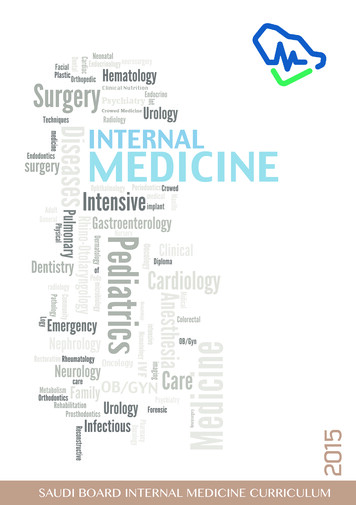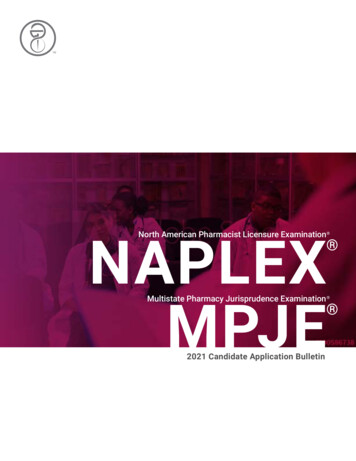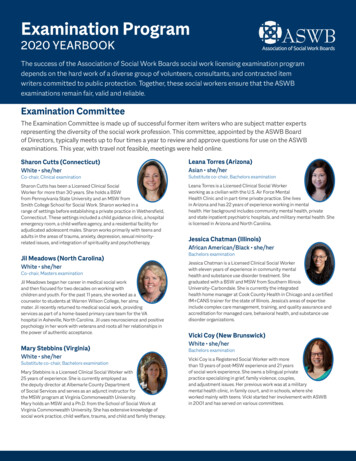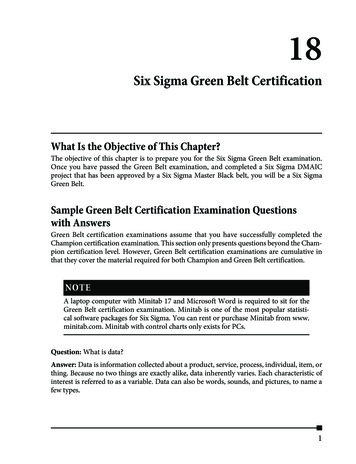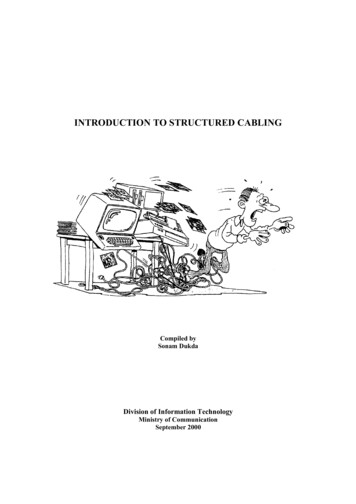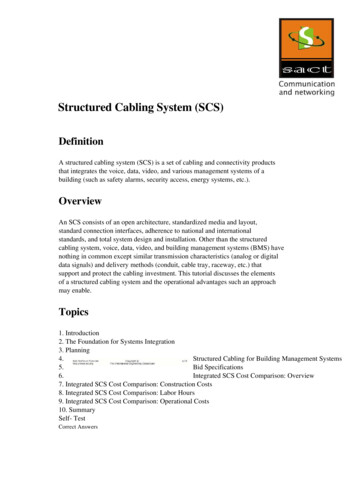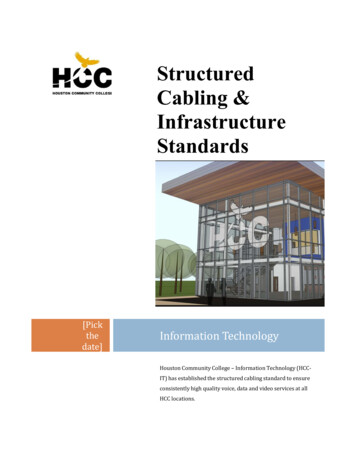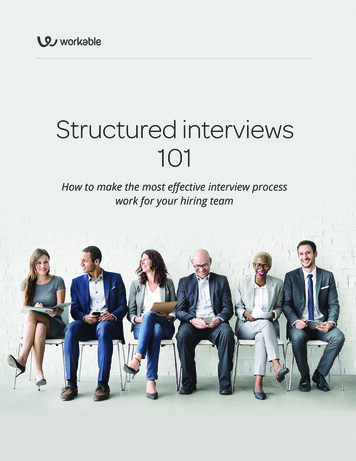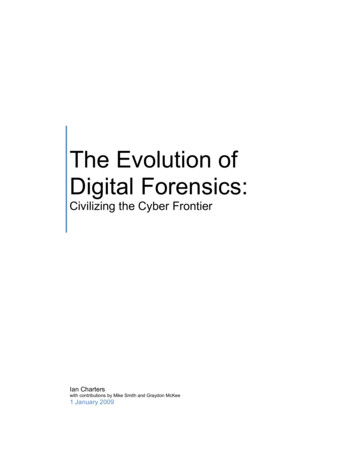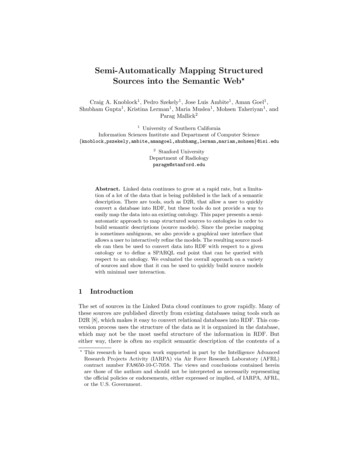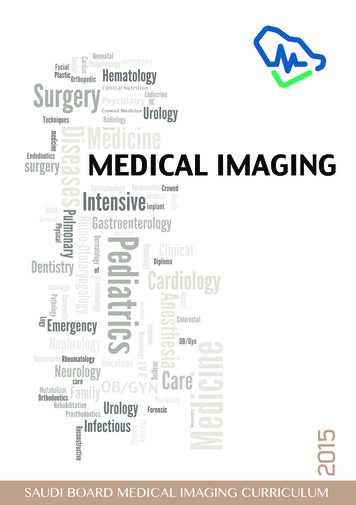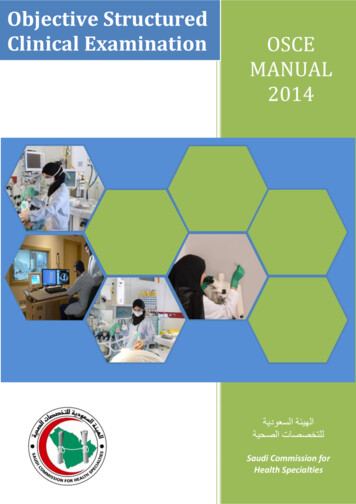
Transcription
Objective StructuredClinical ExaminationOSCEMANUAL2014 الهيئة السعودية للتخصصات الصحية Saudi Commission forHealth Specialties
Prepared by:Professor James WareProfessor Abdelmoniem El MardiDr Hamza AbdulghaniDr Imran SiddiquiFormatted by:Vittoriana Crisera Saudi Commission for Health SpecialtiesKing Fahd National Library Cataloging-in-Publication DataSaudi Commission for Health Specialties, Riyadh - 2014Objective Structured Clinical Examination33p; 14.8cm 21cmISBN: 978-9960-9832-8-81-Clinical medicine – DiagnosisI-Title616.075 dc1435/9119L.D. no. 1435/9119ISBN: 978-9960-9832-8-8
TABLE OF CONTENTSPrefaceiiIntroductioniii-ivChapter 1- Relevant principles of assessment1.1. Clinical Competence1.2. Assessment of clinical competence1.3. Characteristics of a good assessment instrument1.4. The objective structured clinical examination (OSCE)1-91567Chapter 2- Item Construction2.1. Station’s profile2.2 Station’s opening statement2.3. Instructions2.4. Scoring and marking form2.5. List of resources2.6. Stations refinement, calibration and testing - formative OSCEs2.7. Preparing the examinee’s exam book2.8. Recommended standards and regulations2.9. Question banking and station materials10-18101011131415151617Chapter 3- Exam Construction3.1. The Test Blueprint3.2. Converting the blueprint into a test map3.3. Deciding on types of stations3.4. Preparing the exam materials3.5. Recommended standards and regulations19-241920222323Chapter 4- Examination Logistics4.1. Assigning roles and responsibilities4.2. Simulated patients/standardized patients4.3. Orientation and debriefing of the examinees, patients andobservers/examiners4.4. Choosing and preparing the venue including the use ofvideo technology4.5. Preparing the exam materials4.6. Running the OSCE4.7. Marking4.8. Recommended standards and guidelines for the deliveryof the exams25-312528Glossary32-33OSCE Manual 2014282929303031Page i
PREFACEPrefaceThe Saudi Commission for Health Specialties bears the responsibility for bothpostgraduate education and assessment standards of specialist training. Followingthe introduction of postgraduate training in the Kingdom over twenty years ago, theCommission is now undertaking a major overhaul of the programmes offered, thetraining delivered, their accreditation and finally and very importantly the testing ofcandidates.There are many challenges ensuring the right standards of care given by our newlycertified specialists and future consultants. In this respect the Commission would liketo acknowledge the enormously important roles that all our professional colleaguescontribute with.It is no secret that there is no one absolute process that can and should be applied tothe process of assessment. In this manual often several different solutions areoffered for the same purpose and in these cases the individual exam committees willbe free to choose their own solutions. The Commission’s role is to provide theoverall policies and regulations set out in the General Examination Rules andRegulations handbook which is updated and published periodically. We wouldcommend all those who read this manual to read those regulations.The commission has now built three state of the art OSCE centres in Riyadh,Dammam and Jeddah and it is hoped this will encourage all those participating in theimportant task of examining clinical competence.Finally I would like to add my sincere words of thanks to those who have contributedto writing this clear and informative manual.Professor Abdulaziz Al SaighSecretary GeneralThe Saudi Commission for Health SpecialtiesRiyadhOSCE Manual 2014Page ii
INTRODUCTIONIntroductionThis manual describes how to plan, construct and deliver an Objective StructuredClinical Examination (OSCE). An OSCE is an examining process made up of a series ofstations of equal length set in a circuit. A postgraduate OSCE usually has 10-15stations each of eight to fifteen minutes. The OSCE is considered to measure clinicalcompetence and was first created by a group of senior examiners in Glasgow, UK, toreplace the undergraduate finals’ long case, which is inherently unreliable. Since thattime the OSCE has been used in postgraduate and national licensing examinations inthe USA, UK, Canada and Australia among other countries. The Saudi Commission forHealth Specialties has chosen the OSCE to test clinical competence for thepostgraduate medical Saudi Board Examinations. The Commission has also builtthree OSCE centres in Riyadh, Jeddah and Dammam. It is important that assessmenttools are used for their correct purpose, and for example, a structured VIVA whichsome confuse with an OSCE, is used to assess reasoning, critical thinking, judgmentand application of knowledge. The OSCE is a practical test of medical, or surgical,obstetric and so on, practice. In other words what a specialist will actually do. TheStructured VIVA is a theoretical concept and is much more a test of a candidate’sintellectual ability.The OSCE is very resource intensive and should not be undertaken by those withoutexperience. This manual is for examiners with some experience of running OSCEs. Asecond and equally important reason for the manual is to ensure that OSCEs used tocertify specialist competence meet the standards required for a valid, credible anddefensible test.In the chapters that follow there are details for the hands on construction of atesting process that will meet the Commission’s standards for testing postgraduateclinical competence. Examples of what will meet these standards include the use of atest blueprint, provision of written materials to guide examinees, examiners,patients and simulated patients, equipment lists and grading forms. The planning ofan OSCE must begin many months before the delivery date. This will allow for thechoosing of examiners, contacting and training of simulated patients, collection ofexam materials such as X-rays and common medical equipment required to makestations authentic tests of what is supposed to be measured, for example malecatheterization. Training or orientation cannot and should not take place on thesame day as the OSCE itself, instead preferably about one week before, so that thosebeing trained do not forget what has been said.There has been considerable evidence reported from research studies which canadvise how stations should be run. For example, initially it was thought that twoOSCE Manual 2014Page iii
INTRODUCTIONexaminers at a station would be more reliable than just one. The evidence clearlyshows that it is better to use all second examiners to have more stations and therebyincrease the reliability of the whole examination. The way examiners gradecandidates is another important issue and whatever details are used it must ensureevery candidate is assessed in the same way. In fact this is another characteristic ofthe OSCE process that all candidates do exactly the same examination, somethingthat could hardly happen with the long case.Any assessment shall be fit for purpose, in other words an assessment of clinicalcompetence at medical school graduation level shall determine that successfulcandidates meet the minimum standards for safe practice. A test of clinicalcompetence at Saudi Board Part II level is much more about standards of excellencecommensurate with the practice of a specialist. It serves no purpose if the OSCEdesigned for a Saudi Board Part II surgical exam only tests at the level of a graduatingmedical student, where the core undergraduate curriculum consists mainly of thestudy of common conditions. A resident is expected to have in depth knowledge oftheir specialty including unusual conditions. Thus when constructing an OSCE for aSaudi Board Part II exam, counseling a simulated patient over common conditions,such as before an appendicectomy, would probably not be a suitable choice for astation, instead counseling a patient before open heart or parathyroid surgery wouldmake more appropriate tests of clinical competence. However, the choice of stationsstems from the published competencies presented as outcomes of the curriculum/training participated in.Finally, it will be appreciated by reading this manual that to create and deliver asuccessful OSCE requires many administrative duties and so those responsible musthave these resources to ensure success. All members of the OSCE team will bepleased to assist any group who have been tasked with the duty of constructing anOSCE according to the Saudi Commission standards.The Saudi Commission OSCE TeamProfessor James WareSaudi Commission for Health j.ware@scfhs.orgSpecialtiesProfessor Abdelmoniem College of Medicine – Al-Imam elmardi@gmail.comEl MardiUniversityDr Hamza AbdulghaniCollege of Medicine – King hamzaabg@gmail.comSaud UniversityDr Imran SiddiquiSaudi Commission for Health i.siddiqui@scfhs.orgSpecialtiesOSCE Manual 2014Page iv
CHAPTER ONE: RELEVANT PRINCIPLES OF ASSESSMENTChapter One: Relevant principles of assessment1.1 Clinical competenceCompetenceA Proper definition of clinical competence and its components is important to serveas a criterion for validating medical educational programs and to assure a minimumlevel of competency at the end of medical school and beyond during residency.Webster’s dictionary defines being competent as the quality of having sufficientknowledge, judgment, skill, or experience for some purpose. A distinction betweencompetence and performance is often made in the literature. Competence is thepossession of the requisite or adequate ability, having acquired the knowledge andskills necessary to perform those tasks that reflect the scope of professional practice.It may be different from performance, which describes what someone is actuallydoing in a real life situation. Senior (1976), for example, defined competence as whata physician is capable of doing and performance as what a physician actually does.Competencies are a set of professional abilities that includes elements of knowledge,skill, attitudes and experience.Clinical competenceA trainee’s ability to do what is expected at a satisfactory level of delivery, at acertain point in time, e.g. at the completion of the program. It is the acquisition of abody of relevant knowledge and of a range of relevant and related skills whichincludes personal, interpersonal, clinical and technical components. In the case ofclinical education, which is still primarily based on an apprenticeship model, teachersdefine what the trainee is expected to do and then test their ability to do it.However, because of the complex reality of what doctors actually do on a day-to-daybasis, ‘clinical competence’ gives a rather limited view of their work, professionalexperience and expertise. Most clinical actions are concerned with problems forwhich there is no clear answer or no single solution and where no two patients arethe same, even if they have the same condition. An experienced doctor searches hisor her mind and sifts through a wide range of options and in some cases the solutionwill be something he or she has never come up with before. Therefore, competenceitself is best seen as a prerequisite for performance in the real clinical setting whereit would be expected that a doctor operated at a higher level in many areas anddemonstrated mastery in some.OSCE Manual 2014Page 1
CHAPTER ONE: RELEVANT PRINCIPLES OF ASSESSMENTCompetence encompasses a variety of competencies which are divided differentlyinto a number of categories, themes, outcomes or attributes by differentprofessional bodies.Competence as an assessment termGeorge E. Miller (1990) distinguished several hierarchical layers of competence tofunction as a framework within which assessment might occur. The different layersin Miller’s model represent a developmental sequence of stages.Miller conceived competence as a pyramid. The base of the pyramid consists offactual knowledge. One level up, Miller describes the ability to use knowledge in aparticular context as “knows how.” This comes close to clinical reasoning andproblem solving. At a higher level, “shows how” reflects the person's ability to actappropriately in a practical situation and describes hands-on behaviour in asimulated or practice situation. The “does” level refers to actual performance inhabitual practice. The higher the skills being tested in the pyramid, the moreclinically authentic the assessment needs to be.In the field of assessment in medical education, the term competence means theability to apply clinical skills in a standardized setting, the examination setting. Onthe other hand the term performance means the ability to apply clinical skills in areal life clinical situation. Tests of performance carried out in a clinical setting arecalled workplace-based assessment. For the purpose of assessment of clinicalcompetence (assessment of skills mainly), the following simple classifications werefound to be most meaningful:(1)Communication skillsThese skills lead to proficiency in communication - an essential skill for clinicalpractitioners because of the large and varied number of people doctors mustcommunicate with every day and the range of circumstances, some of which mightbe very distressing. The idea that doctors automatically learn communicationthrough experience or that doctors are inherently either good or bad communicatorsis long abandoned. It is now widely acknowledged that both students andpostgraduate doctors can be educated in communication skills and their proficiencycan develop to extremely high levels of expertise.1.a. Communication skills for history takingThese are the skills applied during the interviewing of patients for the purpose ofinformation gathering. The communication skills range from the ability to follow theOSCE Manual 2014Page 2
CHAPTER ONE: RELEVANT PRINCIPLES OF ASSESSMENTagreed consultation framework to the actual use of certain communication skills toinitiate, build and maintain rapport with the patient and thereby facilitate theprocess of information gathering. This competency is usually acquired at two levels.The first level is the ability to apply the techniques in the consultation frameworkand the second level is the ability to take a focused history and analyse the patientresponses.1.b. Communicating with patients in other situationsThese are the protocols for skills used during situations other than history taking,and include: When the consulting practitioner admits mistakes or errorsDiscussion for the purpose of shared decision-makingDiscussions with patients for the purpose of advising or counselingDisclosure of information voluntarily or in response to patients’ questions,when conveying bad news or getting informed consent1.c. Communicating with othersThese are the skills used when practitioners communicate with patients’ relatives,colleagues or the public including authorities and the media1.d. Communicating in writing and electronicallyThese are the skills needed by practitioners to enable them to communicate inwriting and electronically with colleagues and others(2)Physical examination skills2.a. Basic Physical examination techniques:These are the skills used by practitioners when they examine patients with variousclinical conditions. At an early stage of medical education, learners are expected toacquire and master the techniques using basic clinical skills.2.b. Advanced physical examination techniquesLater in their training, learners and trainees are expected to be able to use physicalexamination skills to examine patients and be able to identify, elicit and interpret themajor signs of common clinical conditions.Trainees are expected to know and apply the special tests and techniques like thestraight leg raising test, the tendon reflexes, Valsalva manoeuvre and so on, and toelicit signs like Babinski, Rovsing and clonus.OSCE Manual 2014Page 3
CHAPTER ONE: RELEVANT PRINCIPLES OF ASSESSMENT2.c. Virtual sign identificationAs it is now customary to use multimedia learning resources and simulations in theteaching of clinical conditions, it is expected that residents are able to identifyclinical signs when they encounter them in a virtual reality setting such as withvideos, audio, computer and physical simulations. Investigations were conducted tostudy the predictive validity of virtual identification on the ability of residents toidentify these signs when they encounter them in real patients. Results indicatedthat there is high correlation between the two.(3)Procedural skills3.a. Therapeutic proceduresResidents are expected to learn and acquire a certain level of mastery for somemajor therapeutic procedures like First Aid and Basic Life Support procedures,intubation, application of catheters, injections, suturing, reductions of dislocationsand so on. They are also expected to be able to operate and monitor certaintherapeutic and monitoring devices and to apply a specified range of therapeuticappliances.3.b. Diagnostic proceduresResidents are expected to learn and acquire a certain level of mastery for somemajor diagnostic procedures such as venepuncture, lumbar puncture, fluidaspiration, electrophysiological testing (ECG, EMG), and a range of laboratory andbedside diagnostic tests. They are expected to learn about and be familiar with, butprobably not apply some important diagnostic procedures like imaging,histopathological examinations and molecular biological investigations.3.c. Identification and interpretation of abnormal test findingsPostgraduate trainees are expected to perform all important diagnostic procedures,as well examine results and identify and interpret those that are abnormal.(4)Cognitive skills4.a. Data interpretation (knowledge application)Residents are expected to interpret the data collected during patient interviews toguide them through the physical examination process and interpret the history andexamination data to decide on a plan of management. The examinee would then beexpected to interpret the pattern of all the investigations and build a picture of thecondition the patient is suffering from and reach a definitive diagnosis.OSCE Manual 2014Page 4
CHAPTER ONE: RELEVANT PRINCIPLES OF ASSESSMENT4.b. Decision makingDuring the ordinary clinical work-up, practitioners are expected to be continuallymaking diagnostic, therapeutic and ethical judgments. Therefore decision makingabilities are of paramount importance for clinicians.4.c. Problem solvingThrough data interpretation and decision making skills, medical students acquire theability for problem solving.1.2 Assessment of clinical competenceAccording to the general classification of learning’s three major domains, namelyknowledge (cognitive), skills (psychomotor), and attitude (affect), medical schoolsuse three different types of tests: Achievements tests that mainly focus on assessments of knowledge.Tests of performance (competence) that mainly concentrate on the assessmentof skills.Tests of professionalism, which mainly concentrate on the assessment ofcommunication, ethics and behaviour.There is, however, an unavoidable overlap between the three domains of learningand therefore care should be taken that during testing, emphasis should not beallowed to shift significantly from the intended domain to the overlapping domains.Elstein and his colleagues concluded from their studies in 1978, that clinicalcompetence is highly dependent on the particular content of the situation and theycalled this phenomenon content specificity. According to other studies the ability tosolve clinical problems did not seem to be a general, content-independentcharacteristic of doctors. The reasoning that clinical competence is more than solvingclinical problems was replaced by a perspective that knowledge is an essential factorin all competencies (Van der Vleuten et al., 2000).Tests of performanceVarious types of tests are used to assess the skill components of clinical competence.Users of the various types have their justifications for using any particular approach.It is generally agreed that for an institution to have a fair and comprehensiveassessment of clinical competence, a battery of diverse testing approaches should beused.OSCE Manual 2014Page 5
CHAPTER ONE: RELEVANT PRINCIPLES OF ASSESSMENT1.3 Characteristics of a good assessment instrumentTo judge the utility of any particular assessment instrument, it is necessary to applythe following criteria:a. ObjectivityAn objective instrument is one that assessors can easily agree on what is requiredfrom an examinee as a response or performance when they read the item and whatconstitutes an acceptable (correct) response or performance for which the assessorsassign a grade. It must be remembered, however, that objectivity in not simply thereduction or abolition of examiner subjectivity. When the chance given to examinersto manipulate the questions, answers, responses, performance and judgment areminimized, the chances of objectivity are greatest.b. ValidityThis is defined as the extent to which a test measures what it purports to measure.There is overwhelming evidence that the reliability of measurements of clinicalcompetence is reduced by the fact that competence is content specific.Achieving competence in one area (for example, in one clinical case) is not a goodpredictor of competence in another, even if the areas are closely related. There aretwo main types of validity. The extent to which a test is suitable for the task (fit-forpurpose) is called its face validity. The extent to which the test(s) cover(s) thesubject, discipline or domain is called its content validity. When an examination iscarefully designed through good selection and weighting of the topics to be assessedit is described as having content validity.c.ReliabilityThis is also called repeatability, reproducibility or consistency. It is the extent towhich a test or the instrument if repeated for the same or similar group ofexaminees will produce the same or similar results. A reliable instrument should beboth accurate and precise. So reliability refers to the precision of measurement orthe reproducibility of the scores obtained with the examination. Reliability meansreproducibility of scores across raters, questions, cases, occasions and should becapable of differentiating consistently between high and low ability students.Because competencies are highly domain-specific, broad sampling is required toobtain adequate reliability across content for example, range of cases/situations,across other potential factors that cause error variance for example with testingtime, examiners, patients, settings, facilities. Certain factors are known to improvereliability like objectivity and validity.OSCE Manual 2014Page 6
CHAPTER ONE: RELEVANT PRINCIPLES OF ASSESSMENTe. Educational ImpactExaminations drive learning; this hypothesis describes one of the strongestrelationships in education. Trainees wish academic success, and academic success isdefined by examinations, therefore students will do everything to maximize theirchances of success. The way the exam is conducted also affects the way studentslearn. An instrument that drives students to learn more in depth is said to have higheducational impact.f.The utility indexThe ‘utility index’, described by Cees van der Vleuten in 1996, serves as an excellentframework for assessment design and evaluation .Utility Educational impact x validity x reliability x cost x acceptabilityIt acknowledges that optimising any assessment tool or programme is aboutbalancing the six components of the utility index. Choice of assessment instrumentsand aspirations for high validity and reliability are limited by the constraints offeasibility, such as the resources to deliver the tests and the acceptability to thetrainees. For example, a high stakes examination on which progression into higherspecialist training is dependent will need high reliability and validity, and may focuson this at the expense of educational impact. In contrast, an assessment whichfocuses largely on providing a trainee with feedback to inform their own personaldevelopment planning would focus on educational impact, and less emphasis onreliability.1.4 The objective structured clinical examination (OSCE)The OSCE was first described by Harden in the 1975 in an attempt to overcome theproblems associated with traditional methods for examining clinical competence,such as with unobserved long and short cases and unstructured VIVAs. What wasdescribed was an organizational framework incorporating a variety of test methods.It incorporates the possibility of using a number of different assessment methodswithin the single examination. As a new evaluation tool that allowed trainees to beobserved performing in many different clinical situations, the OSCE was a majoradvance over traditional methods in which only one clinical encounter was examinedbut most often not observed.The OSCE also incorporated the use of standardized patients first described byBarrows and Abrahamson in 1964. The use of standardized patients allowed thenature of problems and the level of difficulty to be standardized for all students (vanOSCE Manual 2014Page 7
CHAPTER ONE: RELEVANT PRINCIPLES OF ASSESSMENTder Vleuten and Swanson). This combination of multiple observations andstandardization of content and difficulty has made the OSCE a very popularevaluation tool.Further, extensive research demonstrated that OSCEs could have excellentpsychometric properties. As a result, the use of OSCEs is now extensively used inmedical schools throughout the world. OSCEs have become indispensable for theassessment of medical students, clinical clerks, interns, and residents as well ascandidates for licensure and certification. OSCEs are also widely used for theassessment of the competence of other health professionals, including chiropractors,nurses, nurse practitioners, pharmacists, dentists, and physiotherapists. As describedby Harden and Gleeson in 1979, the OSCE is a series of stations usually all of equallength, 5-10 minutes, at which various competencies are tested using manned andunmanned stations.Importantly, the measurement is structured, using specially prepared mark sheetswith specific instructions and training provided for the examiners. A time allowancemay be given for candidates to move between stations and often REST stations areinterspersed in the circuit to allow candidates to prepare themselves for the comingstations and complete any incomplete questionnaire. The candidate’s answers fromunmanned stations may be carried in an OSCE book, while examiners record theirmarks on separate sheets which are not given to the candidate.If the OSCE is to attain reliability there must be sufficient stations to neutralise theeffect of case specificity. It is a timed examination in which examinees move fromstation to station; each station requiring performance in a simulated setting thatusually involves interaction with a standardized patient. The examinee is typicallyrequired to demonstrate some combination of history taking, physical examination,counselling, or other aspect of patient management. At each station, candidates’performances are rated on checklists and global rating scales. OSCEs have beenextensively studied and established as performance-based assessment instrumentswith good validity and reliability. Indeed, because OSCEs have been shown to have amuch higher reliability and validity than traditional and less structured oralexaminations, they have grown in acceptance as a means of episodic performancebased assessment. The traditional assessment methods for clinical competence wereseen as being unreliable and often lacking validity.Although having more stations is better than less, there is no absolute number evenfor a high stakes examination. However, when adding the rest stations this may bemore preferable than using multiple circuits. This is not an uncommon solution toOSCE Manual 2014Page 8
CHAPTER ONE: RELEVANT PRINCIPLES OF ASSESSMENTaccommodate candidate numbers at large schools with many candidates to copewith rather than run the same examination on separate days for different sets ofcandidates.The use of paired examiners is no longer recommended and instead a larger numberof stations using all examiners as single observers at the additional stations ispreferred and shown to give better reliability. It is desirable to know how long aborderline candidate might take and determine station length on this basis.Best of all, of course, is to pre-test stations or know from previous editions of theexamination how long chosen competencies take to test effectively. This can bedetermined using formative OSCEs with a limited number of stations.The OSCE is very flexible and can test a wide range of tasks and skills. The choiceshould and will always be within the boundaries set by stated outcomes and morespecific learning objectives. Consideration also needs to be given to whether or notthe candidates are familiar with the format of certain “unusual” stations otherwisethe danger of exam by ambush becomes a problem. To avoid this, again formativeOSCEs even if not full length, are to be highly recommended.Another important issue to address is to satisfy the need for a wide variety of skillsand competencies by using a test blueprint or matrix to design the OSCE itself. In thisrespect, the other exam components should not be forgotten, such as paper tests ofknowledge, and other higher tests of cognition such as MEQs. If the wholeexamination presents an unbalanced and overlapping distribution of competenciestested the value of the OSCE is diminished.The choice of tasks is part of the organizational procedure for setting up a successfulOSCE and above all shall reflect the core competencies expected of the students. Theorganizing team needs also to consider whether an OSCE can reasonably giveinformation about all attributes expected from the candidates at the level of the testor in
2.7. Preparing the examinee [s exam book 15 2.8. Recommended standards and regulations 16 2.9. Question banking and station materials 17 Chapter 3- Exam Construction 19-24 3.1. The Test Blueprint 19 3.2. Converting the
